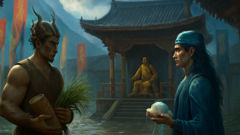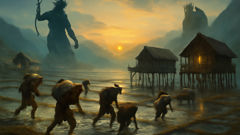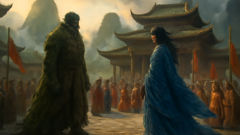Introduction
Long before the modern rice terraces and the humming cities of the Red River Delta, when villages clustered like beads along slow rivers and the mountains stood like patient elders, a court resounded with an unusual summons. In the reign of the Hung kings, a radiant princess named My Nuong—her name whispering like a reed in the wind—became the pivot around which destiny turned. Poets and elders would later say her beauty was not merely a matter of face and form; it was a balancing force in a land where earth and water argued for dominion. The king, proud and anxious to secure his lineage and the stability of his realm, announced a trial to choose a husband for his daughter. He set terms both strange and symbolic: a suitor must present the same objects the princess had been given at birth—a mountain of rare timber, a stallion as swift as the breeze, a feathered cap and a sword, and other extravagant tokens of status. Two contenders arrived with divine claims. From the uplands came Son Tinh, the Mountain God, wrapped in the scent of pine and stone, his eyes steady as cliffs, bringing with him soil and seedlings that promised terraces and footholds. From the brine-sweet estuary surged Thuy Tinh, the Water God, his hair like kelp and voice like the long, rolling tide, with gifts of shells, sea-glass, and the promise of fish in abundance. The court crackled with expectation: this was not merely a marriage but a balancing of elemental wills. What followed would echo across seasons and centuries: a contest of speed, cunning, and elemental power that would transform the landscape itself. That contest is why the rivers rise each year and why villagers still tell the story when the first rains gather, when levees groan and children whisper the names Son Tinh and Thuy Tinh as if naming weather might tame it. In the telling, the tale becomes both explanation and warning, a myth that knits human longing to the vast, indifferent forces of mountain and water. This is the story of how love, rivalry, and the laws of nature performed their relentless choreography, reshaping land and memory until the floodplain itself kept the record of gods at war.
The Courtship and the Challenge
The king's proclamation was measured and final: the suitor who could present the objects the princess had been given at birth by dawn would win the bride. Word spread from the paved court to the thatched houses, and grandfather reeds bent to tell the tale to grandchildren crouched beside the hearth. In the west the mountains listened and in the east the river mouths tasted the copper-sweet air; by dusk two figures had already set themselves in motion.

Son Tinh came first from the high slopes where terraced fields clung like stairways to heaven. He moved with the gravity of stone and the patience of a peak. Villagers who had seen him pass later spoke of rock-smashed sandals, palms inked with soil, and the quiet presence one might expect from a guardian of ridgelines. His gifts were literal embodiments of his domain: stunted pines whose roots unraveled into living anchors, a white horse he led by rein whose hooves left small seedlings in the earth, and a sword whose blade was folded from the heart of ore mined under caves that hummed with mineral music. Son Tinh did not boast. He trusted the slow, relentless accumulation of mountain seasons. "I will bring what the land keeps," he said, offering seeds, stone, and the steadiness of heights.
From the east, propelled by the salt-sleek breath of the sea, Thuy Tinh came with a different kind of courtly grandeur. He arrived as if carried on a tide, garments billowing with the scent of algae and rain, hair braided with shells. His presence suggested movement: the way a river eddies around a boulder, the way currents remember the shape of a shore. Thuy Tinh's offerings glinted in the light—pearls and coral, a blue cloak that slid like water from shoulder to ground, and a trident tipped with lightning-forged bronze. He promised abundance for those who fish and he promised the soft gifts of floodplain silt to enrich soils. "Water sings life into the land," he declared, voice like gurgling currents. "Yield to me and the rivers will bless your fields."
The king, mindful of symbolism as of rule, laid out the ritual: both suitors would be judged not only for the richness of their gifts but for their speed and fidelity to the items the princess had received at birth. At dawn, both men prepared: Son Tinh stacking terracotta and seed, Thuy Tinh summoning waves and rain. The court at first applauded both possibilities—the steady mount and the generous flood—yet there was a tension like a storm edge in the air. When Son Tinh presented his treasures in precise order, the king's face softened. The mountain's goods were tangible: the horse, the small carved gate to the princess's house, the timber pillars that would lend weight to future roofs.
But Thuy Tinh was not to be outdone. He moved the waters and in a brilliant display of control he produced exactly what the king described, mirroring the birth gifts with salt-lacquered equivalents. For a heartbeat the court shivered, watching gifts emerge like refracted light. The king consulted his advisors, debated omens: smoke patterns from incense, the flight of a heron on the river, the counsel of a village elder whose knuckles were mapped with the memory of many floods. In the end, honor and earthly practicality guided his choice—Son Tinh had arrived first and his offerings matched exactly the tokens of the princess's birth. Thus Son Tinh was proclaimed the winner and preparations for the wedding began with haste.
Thuy Tinh's face, at that declaration, hardened into a surface like a pond turned to ice under a sudden frost. Ebbing from the court with the slow dignity of a withdrawing tide, he swallowed a low sound that might have been anger or sorrow; the sea, a jealous partner, answered. Within hours, clouds gathered where none had been promised, and the eastern horizon bent under a bruising sky. Villagers, however, danced and prepared wreaths of jasmine for the bride and groom. Drums pounded the rhythms of ceremony and lanterns were strung from rafters, their paper skins trembling with expectation. The wedding feast became a festival of earthly delights; people told their children to look to the hills and give thanks because the mountains had won the hand of the princess. They did not yet know the weather that Thuy Tinh would bring.
When the bridal procession began, banners flapping like birds in flight, Thuy Tinh returned. He did not come with rude force at first; he came with the strategy of his element. He raised waters—small at first, in curious fingers along streambeds, then more insistently as rivers remembered his summons. He spoke in tones that moved clouds to weep; he sent rain that made the soil smell of riches and threat at once. Villagers watched their pathways soften into mud and the festival drums sounded softer as the rain made a wreath of silver around lamps. "I will take the bride," Thuy Tinh thundered. "If the princess cannot be mine, I will take every field and house that stands between my currents and the mountain's base."
Son Tinh, hearing the rumble of a force he could neither ignore nor wholly contain, rose as mountains do: with rumination and countermeasure. He called upon the bones of the earth, and ridges rearranged themselves into levees. Stone walls jutted like the teeth of an old creature, terraces rose and slopes hardened. Where Thuy Tinh sent his waves, Son Tinh's peaks lifted, deflecting and diverting. The bridal procession, caught between rising water and rising ridge, fled to safety along a narrow spinal road Son Tinh carved from a cliffside. Thuy Tinh's anger pounded the land: low-lying villages saw rice paddies fill with a quickness that made people wail; boats found themselves at strange heights, perched in courtyards like stranded fish. In the end the princess remained with Son Tinh, not by coercion but because the mountain's shelter had become the only asylum stable enough to hold a household together.
Yet Thuy Tinh's retribution did not end in one season. In the months that followed, he would return each year, swelling rivers in memory of his lost claim. The people learned—by labor and lore—to build embankments, to plant trees on dikes, to time harvests to the moods of the sky. They told the tale of the court's fateful contest not to scold but to teach: respect both mountain and water, for each holds a claim over life and land. The wedding feast turned into ritual remembrance and, in time, into practices of mitigation. The myth thus lived on, braided into levee-building and seed selection, explaining both calamity and caution. Where the land rose, terraces held; where the water surged, silt renewed the fields. The world learned equilibrium through the clash of gods.
When elders now recount these events—by river and hearth, beneath trees whose roots tilt like wise old heads—they do so with a mixture of humor and supplication. They speak of Son Tinh's laughter when a child asks why a mountain forbids a flood and of Thuy Tinh's watery sighs when levees hold for another season. The contest in the court was at once a romantic episode and a parable of the choices that bind human communities to their environment. It told of how kings, divine claimants, and everyday people negotiate the borderlines of habitat. It also told of how anger, unquenched by marriage, can find its outlet in weather and tide. The story is not a dry recounting of events but a living, breathing explanation that ties the rise of rivers to the jealousies of gods, and the construction of dikes to the wisdom gained from loss.
In villages near the river the children still play a game that mimics the contest: one child is mountain, the other becomes water, and the village border becomes a disputed line. Without fail, an old woman will join to remind them how to build a simple levee, adding a practical lesson to the drama. The myth thereby remains an active curriculum, a cultural blueprint for resilience. It is neither entirely tragic nor wholly triumphant. It is a negotiation of permanence and flux. The courtship and the challenge explain why the river remembers every year and why the mountain keeps its vigilance: both are necessary, both demand respect, and both teach the people to live with the unpredictable pulse of the natural world.
The Battle of Mountain and Water
After the wedding, when lanterns had dimmed and the guests had left traces of rice and song on the palace steps, the real contest began—one that would not fit into a single night. Thuy Tinh retreated to his estuaries and deep channels to gather strength, while Son Tinh returned to his highlands to shape barriers and fortify slopes. Their conflict became more than a rivalry between two gods; it became an ongoing negotiation visible in the rhythms of seasons, recorded in the river lines, and imprinted on local architecture. The land remembers their feud with honesty: in the way levees are heightened year by year, in terraces realigned to follow the contours of floodwater, and in the tiny shrines by the roadside where offerings are made to both mountain and water before planting.

The first return of Thuy Tinh after the wedding was not a simple flood. It was a deliberative, almost surgical movement of water that tested human defenses and divine patience. He sent a chorus of heavy rains that rose from the sea as if riding a long, low swell, and the rivers answered with a terrible, slow applause. Villages in the floodplain watched dikes weep and then break; houses that once sat dry were inundated in hours. With the first flood came the first song: women calling to each other across small islands of dry roof, fishermen cutting ropes to set adrift the floating granaries, children learning how to plank roofs into little rafts. Thuy Tinh's anger manifested as a force that stripped away comforts and also deposited the brown, fertile silt of the sea and river mouths. Where soil had been exhausted by one season of heavy harvest, the flood returned life, albeit at the cost of disruption.
Son Tinh's reprisals were slower but just as cunning. He raised banks, called forth stone and root, and shifted minor ridgelines so that water found new channels. He summoned gusts that dried the tops of swamps and sent herds into higher pasture. The mountain’s actions were not purely defensive: at times Son Tinh rearranged the land so that floodwaters widened into wetlands where fish could spawn, and at other times he crafted ridges to shelter hamlets behind a stony embrace. People began to see these changes as Son Tinh's quiet parenting of the countryside—he taught them which slopes to cultivate, where to plant sugarcane and where to leave reeds for basket-makers. His guidance was a curriculum in geomorphology disguised as divine favor.
As the years unspooled, the cycle settled into a pattern both terrifying and strangely predictable. Thuy Tinh would muster rains and waves, sending rivers to reclaim parts of the plain; Son Tinh would answer by lifting terraces and building stony teeth to catch the onrush. Children born in the floodplain learned to read waterlines in the bark of trees and to recognize the scent of silt as an omen. Families planned marriages and harvests around the memory of previous seasons, and entire communities evolved building methods that took the gods into account: houses set on stilts, rice grown on floating rafts for emergency use, and granaries raised on plinths. The myth taught practical architecture as much as it taught moral caution.
Beyond the engineering, the battle shaped ritual life. Each spring, before the monsoon, villagers would visit both mountain shrines and river altars. They would offer simple gifts—fruit, salt, incense—to ask Son Tinh for shelter and Thuy Tinh for mercy. Priests and elders recited versions of the original court's judgment, reminding people that neither god was wholly evil or wholly benevolent; each had a rightful domain and each a right to express displeasure. Festivals emerged around these acts of supplication: a river festival of boats lit with candles to appease Thuy Tinh, and mountain pilgrimages to plant new trees and reinforce terraces to honor Son Tinh. These rituals became embedded in the agricultural calendar, blending spiritual practice with the practicalities of survival.
Poets and storytellers amplified the drama, turning it into a living epic that could be reshaped with each telling. One teller would emphasize Thuy Tinh's heartbreak—how the god of water had loved a mortal princess and therefore poured his grief into the tides; another would praise Son Tinh's guardianship, the way he raised paths for travelers and sheltered communities from maritime wrath. Sometimes the story was told as moral allegory: pride and jealousy bring calamity; cooperation between different people and places brings prosperity. More often, though, the tale remained richly ambiguous: both gods were necessary, both could be cruel, and both could be kind. The people learned to live in the tension, to negotiate microcosms of the cosmic feud in their daily choices.
Natural features on the land took on names and shapes that referred to the battle. A jagged boulder might be called the god's clenched fist; an inlet might be remembered as Thuy Tinh's weeping curve. Maps handed down across generations sometimes carried not only topography but also the printed memory of the gods' footprints. Schoolchildren recited verses that began with the court decree and ended with the observation that the plain was born of argument. The story thereby worked as mnemonic—a way to keep knowledge about flood risk and landscape management alive in the tongues and hands of ordinary people.
When floods came now, the community response was shaped by that memory. Men and women who once might have panicked now moved with choreographed calm: boats ferry the elderly, grain is stacked on high platforms, levees are patched in an almost ceremonial rhythm. That's because they had learned, through an oral lineage of narratives, how to read the world. The myth of Son Tinh and Thuy Tinh did more than explain the weather; it introduced a social script for resilience. Its characters embodied the forces that threatened and sustained agriculture—mountain and water—and parents could teach appropriate responses through story rather than abstract instruction.
Over the centuries the gods' conflict invited reinterpretation. Some artists turned it into romantic drama, a tale of impossible love. Others turned it into cautionary epic about stewardship and hubris. Modern environmentalists sometimes point to the story when advocating for integrated watershed management: you cannot favor only mountains by paving slopes and expecting rivers to stay quiet; you cannot let rivers reclaim the land without planning for the seasonal pulse of water. The myth, thus, remains relevant because it contains practical lessons encoded in narrative form. It tells people to respect both solid and fluid, to treat boundaries as permeable and negotiable rather than absolute.
To this day, when rains thicken the horizon and the air tastes like the sea, villagers bring offerings to both shrines: incense on mountain ledges, rice on riverbanks. Children run laughing between the two, pretending to be Son Tinh and Thuy Tinh, and elders smile because the game keeps the memory alive. The battle between mountain and water continues not as a single, climactic war but as an ongoing negotiation—sometimes violent, sometimes cooperative—that shapes the daily rhythms of life. In these rituals, the gods are not distant; they are neighbors whose moods must be read. The myth provides a framework by which a society understands and adapts to natural cycles, and in doing so it transforms fear into care and rivalry into a reason for community planning and mutual aid.
Conclusion
The story of Son Tinh and Thuy Tinh endures because it speaks to a deep truth: human life depends on negotiating forces far larger than ourselves. It is a myth told at hearths and in schoolyards, in festivals and in the pragmatic labor of levies and terraces. The mountain god offers shelter, soil, and stability; the water god offers fertility, movement, and, at times, devastation. Their rivalry explains the annual floods and instructs a people on how to live with them—by remembering, building, and honoring both mountain and water. Each year, when clouds gather and rivers swell, villagers raise their eyes to ridges and to tide, remembering that the gods' argument is not ended but transformed into a shared responsibility. The narrative, embroidered with sensory detail and cultural ritual, becomes an ongoing lesson in resilience: prepare your defenses, respect the pulse of the rivers, and understand that the land's abundance is bound up with a fragile compromise. In that compromise lies wisdom—an invitation to balance the solidity of stone with the inevitability of water, and to live with humility in a world shaped by forces beyond human command.


















